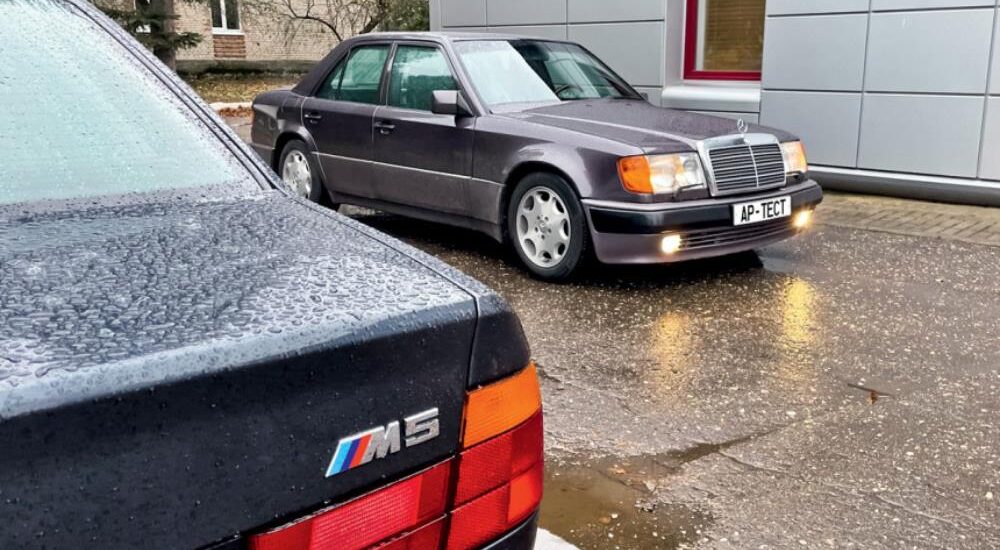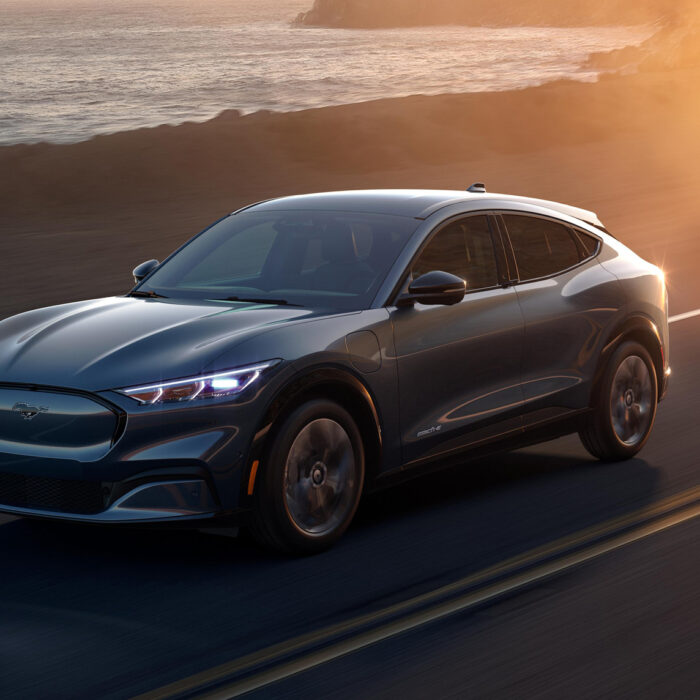Quando a Mercedes anunciou o W124, a BMW reagiu com o E34. A resposta de Munique foi clara e clara com a proclamação do M5, e Stuttgart foi rápida em responder com o 500 E. Curiosamente, apesar das grandes diferenças entre esses supersedãs, eles compartilhavam um ponto de partida peculiar: ambos começaram suas viagens em uma carroceria de caminhão.

O projeto W124 começou em 1977, com o design inicial elaborado por Peter Pfeiffer e Josef Gallitzendörfer, e foi finalizado pelo chefe do centro de estilo, Bruno Sacco.
O tom da rivalidade foi inegavelmente estabelecido pela BMW na década de 1980, impulsionada pela ambição de superar a Mercedes. A competição foi tão acirrada que Munique teve que dobrar seus esforços apenas para manter a perseguição. Eles precisavam de um avanço para obter uma vantagem, que veio com o lançamento do E32 ‘Seven’ em 1986, seguido pelo BMW 750i com motor V12 um ano depois. O desafio então era replicar esse sucesso com o ‘Five’.
Lançados em 1988, os sedãs E34 foram criados com um foco único: superar o formidável W124. Quatro anos após sua estreia, a Mercedes ainda era uma maravilha da engenharia automotiva. Durante nosso teste retrô, mergulhei no BMW Praxis, um catálogo de revendedores usado para treinar vendedores sobre o novo ‘Five’. Este manual de 240 páginas é um tesouro de detalhes sobre o E34, repleto de informações raramente encontradas em outros lugares.
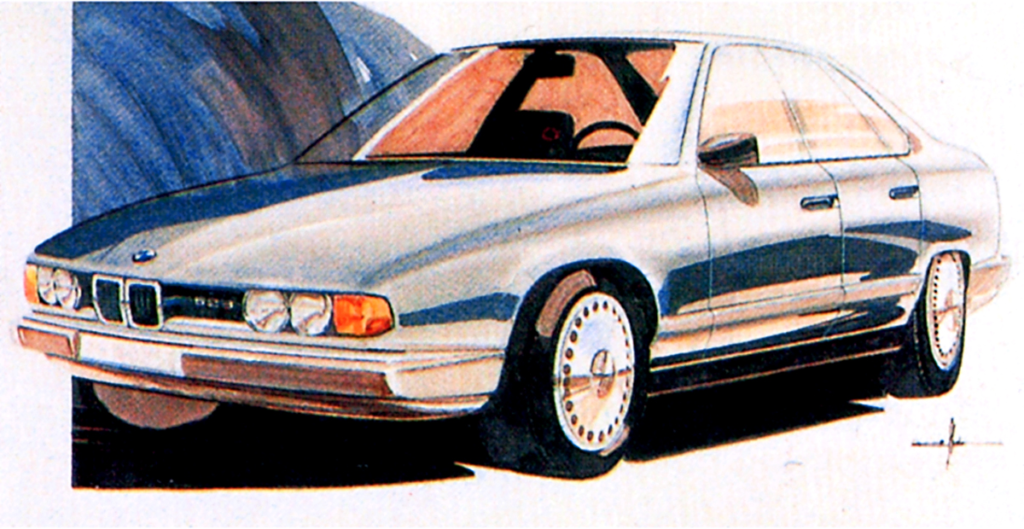
Os genes italianos do E34 foram esboçados em 1982 por Ercole Spada. O trabalho no “Five” foi continuado por Jay Mays, e concluído sob a orientação de Klaus Luthe.
De estratégias de marketing a inovações técnicas, a rivalidade foi intensa. A BMW analisou as participações de mercado em várias profissões, observando uma preferência pelo ‘Propeller’ entre os gerentes de nível médio e pelo ‘Star’ entre os principais executivos e freelancers. A BMW também elogiou melhorias na aerodinâmica, alegando uma melhoria de 18% em relação ao seu antecessor e alcançando um coeficiente de arrasto de 0,30, mantendo seu design icônico de grade. Sutilmente, eles deram a entender que seus resultados poderiam ter sido ainda melhores se não fosse por sua política de pneus padrão — um golpe na Mercedes, cujos melhores valores aerodinâmicos foram alcançados com pneus mais estreitos.

O equilíbrio entre funcionalidade (eixo vertical) e estética (eixo horizontal) percebido pela BMW. Acontece que a Lancia é a menos prática, enquanto a Audi é considerada a menos bonita.
Inovações como o sistema de limpador exclusivo da Mercedes, que limpava 86% do para-brisa, foram atendidas com os limpadores estendidos da BMW que combinavam com a área de limpeza, mas adicionavam um mecanismo para melhor desempenho da lâmina em baixas velocidades. Da mesma forma, enquanto a Mercedes possuía aquecimento automático para espelhos e jatos, a BMW introduziu um mecanismo de trava aquecida ativado ao segurar a maçaneta da porta — uma característica de engenharia cuidadosa.

É evidente como as empresas trabalharam de forma diferente com o front-end. Para a Mercedes, a ótica e a grade atuam como uma ferramenta aerodinâmica que ajuda a reduzir a sustentação. Para a BMW, os faróis são principalmente a cara da marca. No entanto, o catálogo BMW Praxis fornece números intrigantes: para superar a resistência do ar a uma velocidade de 180 km/h, o E34 precisa de 64 cv e, a 200 km/h, precisa de 87 cv. Isso é 20% menos do que seu antecessor, o E28, com um nariz de tubarão semelhante.
Cada modelo introduziu recursos projetados para superar os outros. A famosa suspensão traseira de cinco elos da Mercedes foi recebida com os aprimoramentos da BMW na configuração existente do E34, incluindo amortecedores controlados eletronicamente e um sistema de direção Servotronic. A BMW também respondeu ao ASR da Mercedes com seu avançado sistema ASC+MSR, que abordava não apenas a tração, mas também o bloqueio das rodas durante a desaceleração.
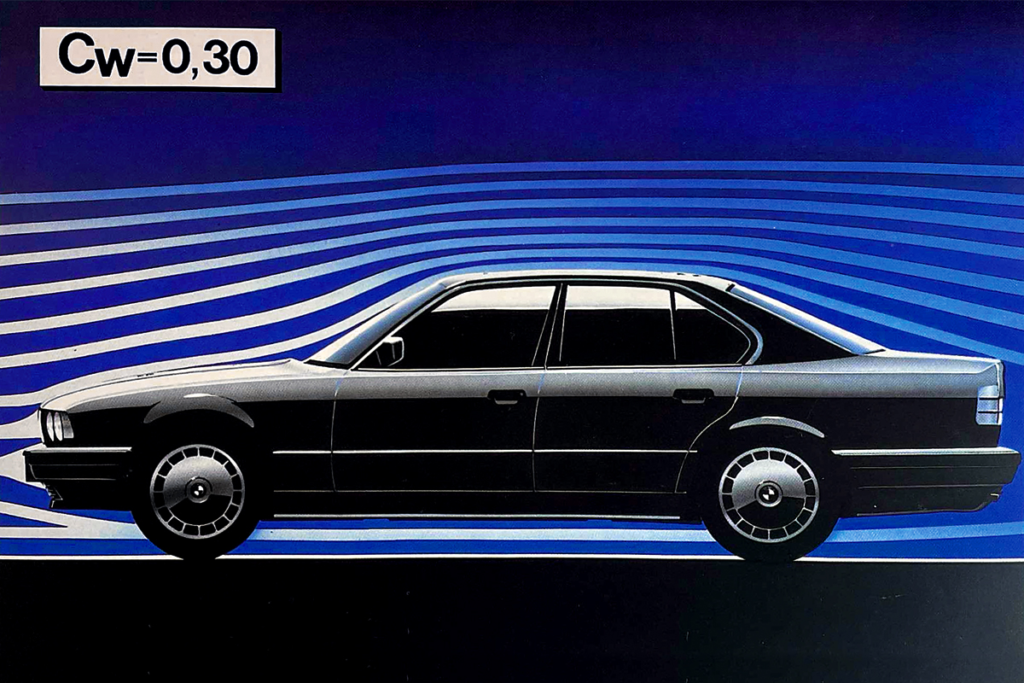
O catálogo até forneceu uma justificativa para as características de manuseio do M5, sugerindo que a BMW ajustou intencionalmente o chassi para uma subviragem neutra a leve, que poderia passar para sobreviragem com a entrada do acelerador, presumivelmente para contrariar a natureza relaxante da Mercedes.
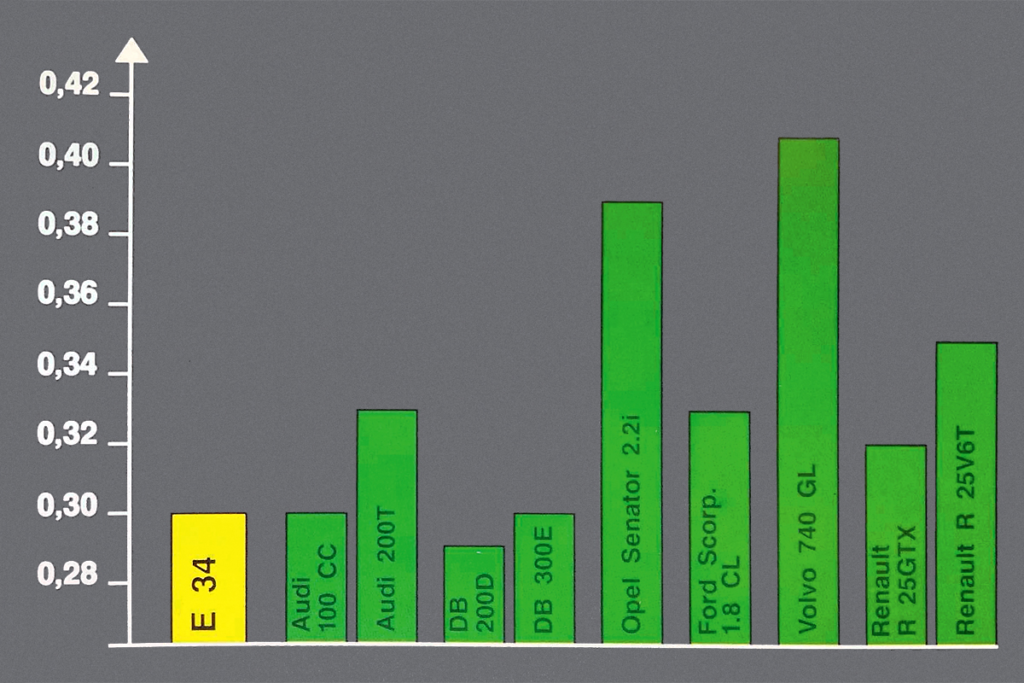
A aerodinâmica dos clássicos e contemporâneos. Para alcançar a Mercedes, a BMW retirou funcionários da Audi.
Essa batalha contínua pela superioridade não apenas ultrapassou os limites tecnológicos, mas também ressaltou uma profunda rivalidade. Embora o E34 tenha se destacado momentaneamente à frente do W124, ele não conseguiu replicar o impacto revolucionário do V12 E32. Apesar de compartilhar uma plataforma com o ‘Seven’, o ‘Five’ sempre pareceu um passo atrás de seu homólogo de Stuttgart, buscando inovações como tração nas quatro rodas e aprimoramentos de segurança pioneiros da Mercedes.
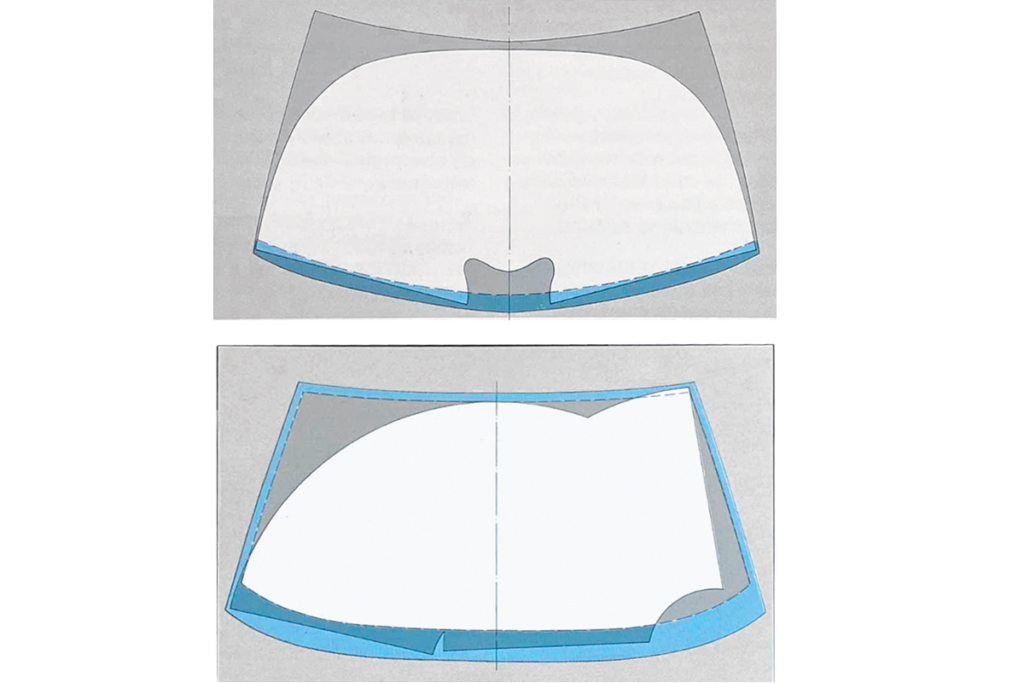
O limpador da Mercedes alcança as curvas superiores e fornece uma área de limpeza recorde do para-brisa para a indústria automotiva. A BMW insiste que o canto superior esquerdo é mais importante para a visibilidade nos semáforos.
O BMW M5 continua sendo uma prova dessa competição feroz, incorporando a busca incansável pela excelência e inovação automotiva. À medida que esses rivais se esforçaram mutuamente para maiores alturas, eles deixaram um legado de proeza e desempenho de engenharia que continua a inspirar o mundo automotivo.
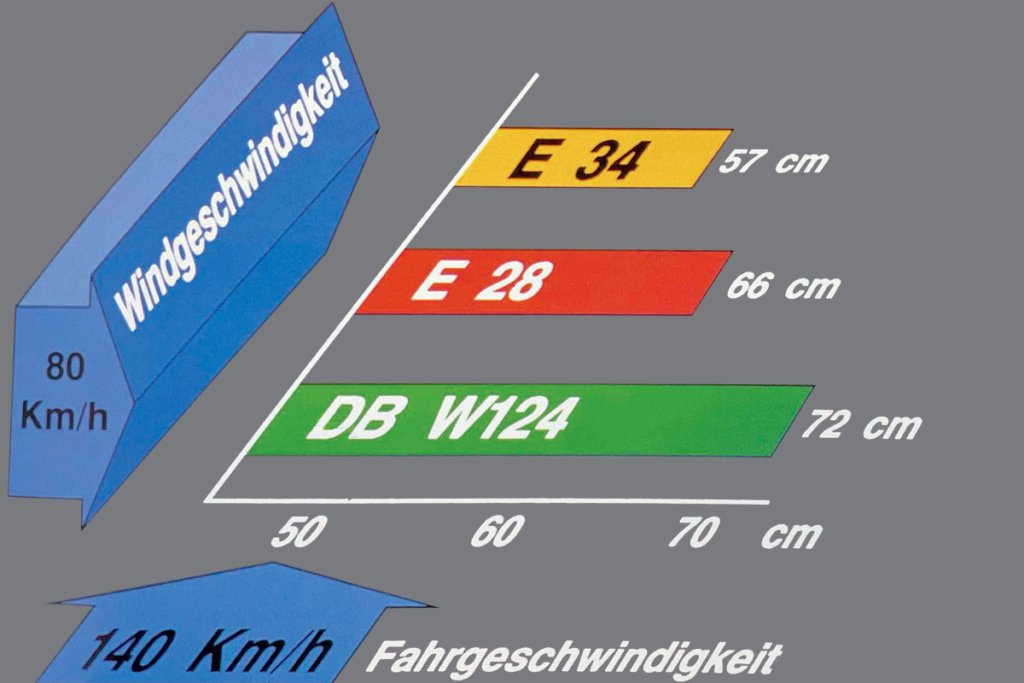
Outro motivo para destacar a superioridade sobre a Mercedes: nos ventos laterais, o E34 deriva menos que o W124.
Quando a Mercedes apresentou o W124, a BMW respondeu rapidamente com o E34, anunciando sua própria obra-prima, o M5. O balcão de Stuttgart, o 500 E, marcou o início de uma rivalidade fascinante entre dois supersedãs distintamente diferentes, ambos compartilhando uma origem surpreendente: cada modelo começou sua vida no chassi de um caminhão.
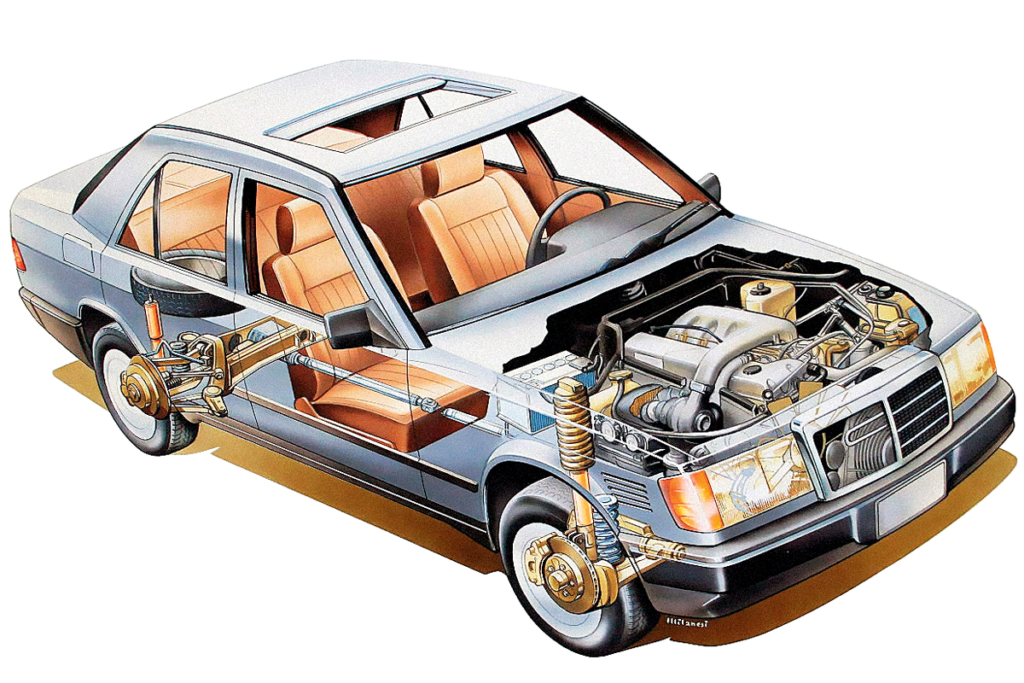
A principal joia técnica do chassi W124 é a suspensão traseira multi-link, que apareceu um pouco mais cedo nos sedãs menores W201 e foi posteriormente instalada em quase todos os carros de passeio da Mercedes. Foi copiado por muitos outros fabricantes. Com modificações, esse esquema básico de cinco links ainda é usado hoje.
A década de 1980 viu a BMW se esforçar fervorosamente para superar a Mercedes. Stuttgart foi formidável, forçando Munique a dobrar seus esforços apenas para acompanhar o ritmo. Para superar a Mercedes, a BMW precisava de algo extraordinário. Eles foram entregues em 1986 com a estreia do E32 ‘Seven’ e surpreenderam ainda mais o mundo automotivo um ano depois com o BMW 750i movido a V12. O desafio era replicar esse sucesso com os ‘Five’.
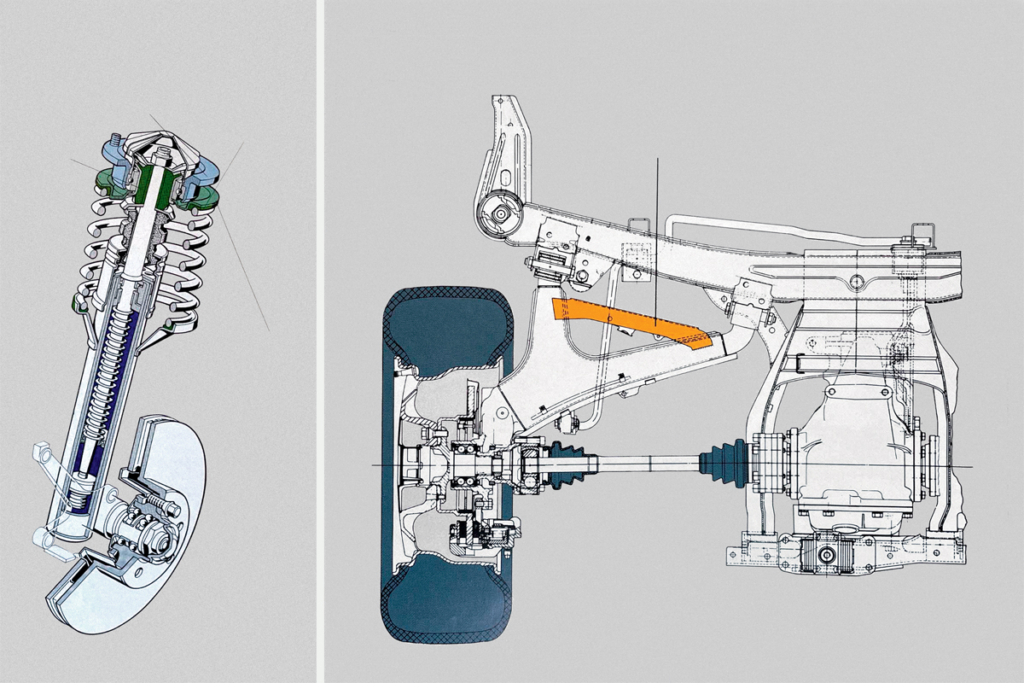
Para todas as versões E34 acima do BMW 525i e 524td, foram fornecidas escoras McPherson com suportes separados para molas e amortecedores. Na traseira, os braços oblíquos foram reforçados com aparelhos. Este foi o último “Five” com um eixo traseiro tão antigo. Como opcional, com exceção do M5, foi oferecida uma suspensão Sport mais rígida.
Lançados em 1988, os sedãs E34 estavam focados em um único alvo: o excelente W124. Quatro anos após sua estreia, a Mercedes ainda simbolizava o apogeu da engenharia automotiva.
Durante nossos testes retrospectivos, passei vários dias com um catálogo exclusivo de revendedores, o BMW Praxis, projetado para treinar a equipe de vendas no novo ‘Five’. Esta Bíblia de 240 páginas do E34 cobre cada detalhe minucioso e decisão de design do veículo. Está repleto de insights exclusivos e custa 30.000 rublos — uma prova de seu valor. Notavelmente, o W124 é mencionado em quase todas as páginas, ressaltando uma aparente obsessão.
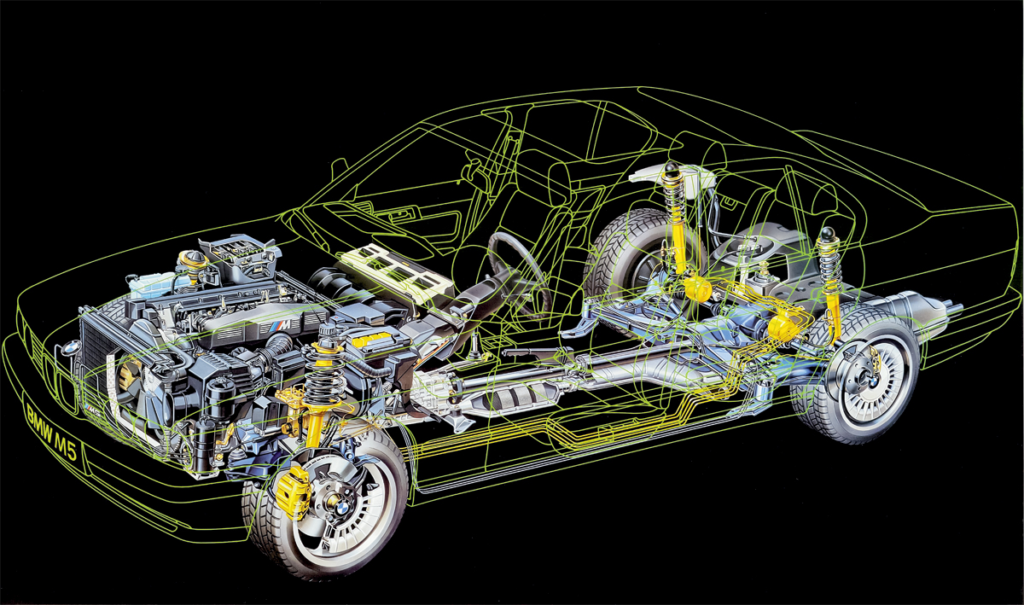
A suspensão multilink complexa comparável da BMW só apareceu em 1989 no cupê E31, e depois no “Seven” E38 e “Five” E39. Mas o M5 E34, mesmo antes do Mercedes 500 E ser lançado, era equipado de série com amortecedores traseiros com um mecanismo hidráulico de autonivelamento para manter os ângulos de cambagem e a folga constantes das rodas.
A batalha começou com estratégias de marketing, com a BMW investigando comparações detalhadas de participação de mercado em várias profissões. A marca ‘Propeller’ ressoou mais entre os gerentes de nível médio, enquanto a ‘Star’ foi popular entre os principais executivos e freelancers. A BMW também se gabou de proezas de engenharia, alegando uma melhoria aerodinâmica significativa em relação à sua antecessora e alcançando um coeficiente de arrasto de 0,30, preservando a icônica inclinação negativa de suas narinas. Sugeriu sutilmente que esses resultados poderiam ter sido ainda melhores, sugerindo que concorrentes como a Mercedes usaram pneus mais estreitos para obter os melhores valores.
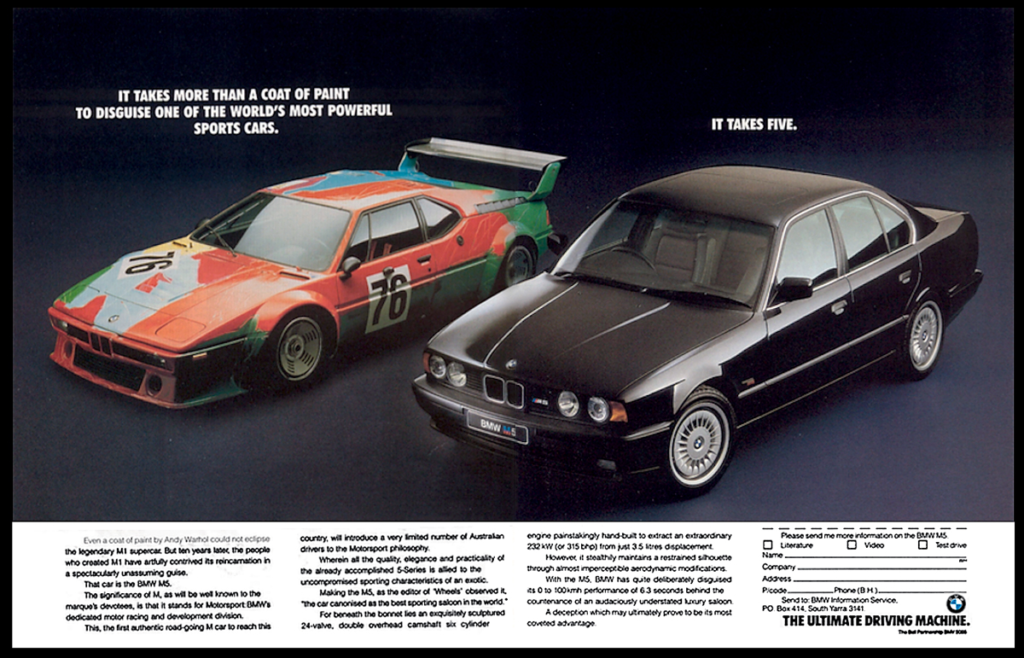
A linhagem de motores M5 é tradicionalmente rastreada até os “seis” M88 do BMW M1, embora o verdadeiro progenitor fosse o BMW 3.0 CSL. A versão M88/3 sem cárter seco foi alocada ao E28 M5 na Europa, enquanto o primeiro motor rotulado S38B35 foi sua versão “catalítica” para a América. Os motores S38 do E34 herdaram um bloco de ferro e um cabeçote DOHC de 24 válvulas.
A BMW igualou o inovador sistema de limpador de para-brisa da Mercedes, que limpou 86% do vidro ampliando o alcance dos limpadores e adicionando um mecanismo na base para melhorar a aderência da lâmina em baixas velocidades. Eles também introduziram um recurso exclusivo em que puxar e segurar a maçaneta da porta ativa um aquecedor de trava, uma adição inteligente para climas mais frios.
Desde os encostos de cabeça traseiros dobráveis operados por servos em vez de molas até um sistema de controle de tração mais sofisticado que gerenciava tanto a perda de tração quanto a desaceleração repentina, a BMW parecia determinada não apenas a competir, mas a liderar em inovação. Os novos recursos de cada modelo visavam superar os outros, com a BMW refinando continuamente seus designs para responder aos avanços da Mercedes.
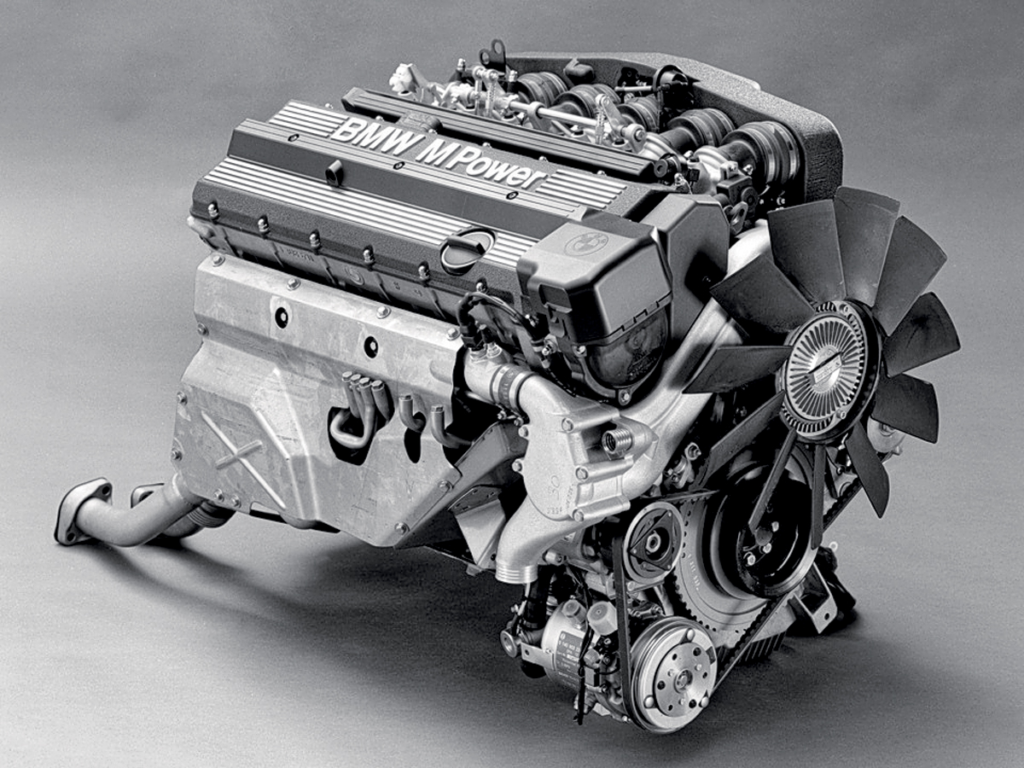
O motor S38B36 (315 cv) do M5 pré-facelift na verdade tinha uma cilindrada de 3535 cc, mas foi designado 3.6 para diferenciá-lo do motor antecessor com uma cilindrada de 3453 cc no M5 E28.
Além disso, o catálogo da BMW forneceu uma justificativa para as características de manuseio do M5, indicando um ajuste deliberado de subviragem neutra para leve, que poderia passar para sobreviragem ao acelerar, talvez um aceno à natureza “flutuante” do “124″.
Essa rivalidade olho por olho não apenas ultrapassou os limites da tecnologia automotiva, mas também destacou o intenso espírito competitivo entre as duas marcas. Embora o E34 tenha se destacado brevemente à frente do W124, ele não conseguiu replicar o impacto inovador do E32 de doze cilindros. Apesar de compartilhar uma plataforma com o ‘Seven’, o ‘Five’ estava sempre em busca, adotando inovações como carrocerias de station wagon, tração nas quatro rodas e recursos de segurança aprimorados que ecoaram os pioneiros da Mercedes. O BMW M5 continua sendo um monumento a essa feroz rivalidade, demonstrando como a concorrência impulsiona a inovação e a excelência na indústria automotiva.
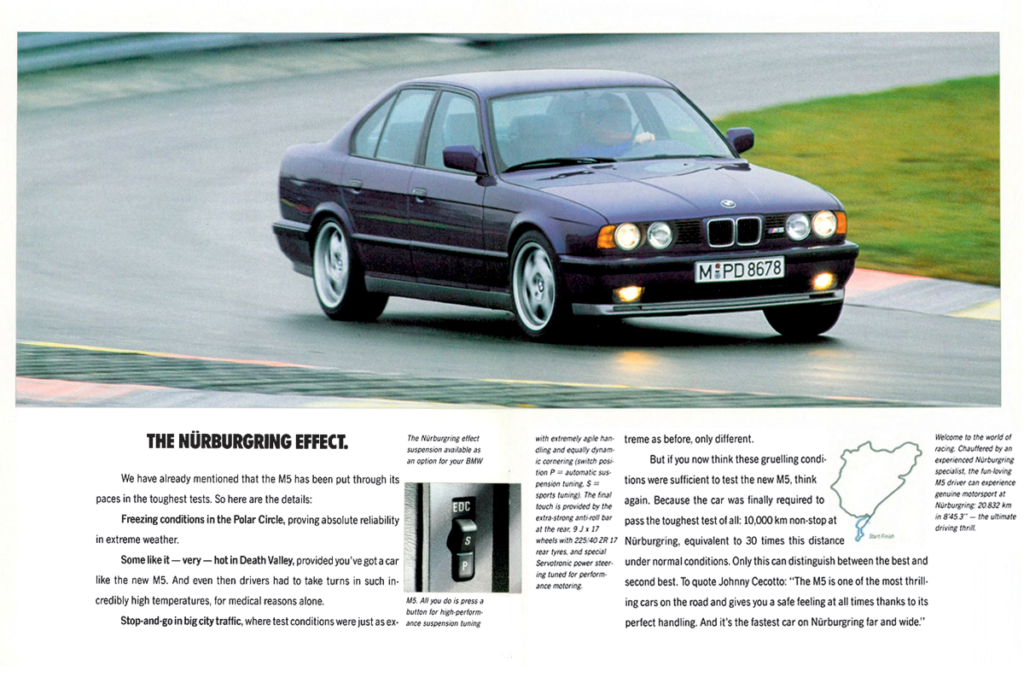
O efeito Nürburgring significa que, durante os testes, o sedã BMW M5 com amortecedores EDC adaptativos completou dez mil quilômetros ininterruptos no “North Loop” de Nürburgring e registrou o melhor tempo de 8m45,3″ (em uma pista de 20.832 km).
Três anos atrás, para marcar o 30º aniversário do Mercedes 500 E, o serviço de imprensa da Porsche divulgou uma entrevista com Michael Hölscher, líder do projeto do Typ 2758. As aparições subsequentes de Hölscher no podcast lançaram mais luz sobre as nuances de desenvolvimento desse modelo icônico. Ele esclareceu que o layout do sedã, a seleção do motor e da transmissão do roadster 500 SL, junto com seu design e aerodinâmica, foram todos determinados exclusivamente pela Mercedes. A Porsche foi encarregada principalmente de integrar esses componentes ao chassi do W124, que inicialmente não havia sido projetado para abrigar motores V8.
Essa colaboração exigiu adaptações significativas, incluindo a realocação dos dutos de admissão, o redirecionamento das linhas de freio e combustível, ajustes no túnel central, a ampliação da pista e a realização de um programa abrangente de testes de direção. Curiosamente, a Mercedes optou por não incluir o ajuste de Nürburgring neste projeto, ressaltando um cenário em que as especificações do cliente eram fundamentais para a Porsche.
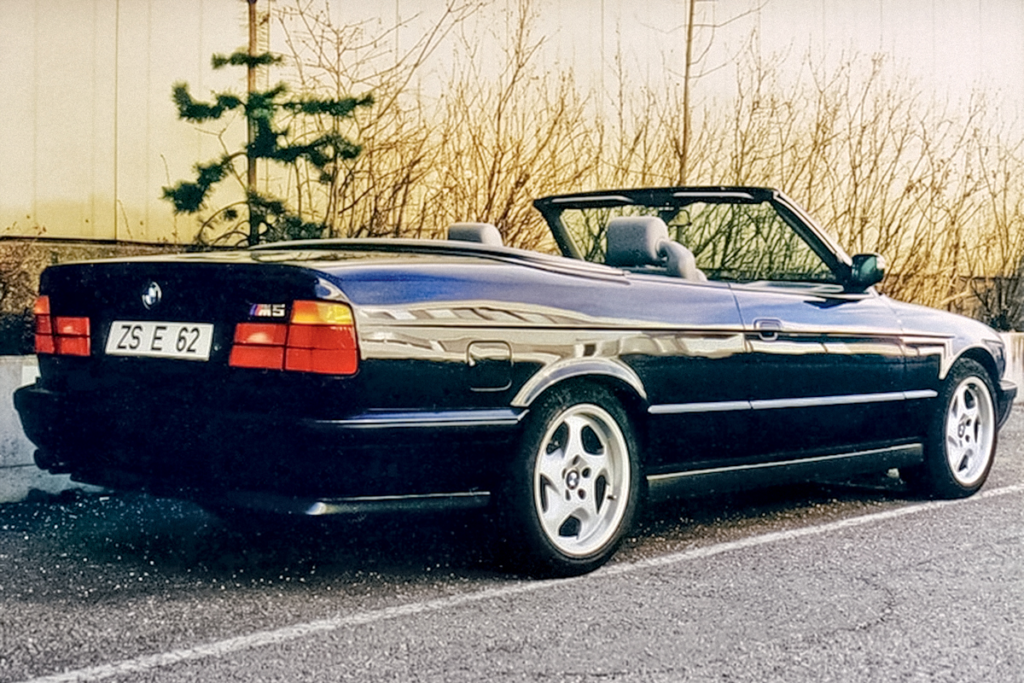
No Salão de Genebra de 1989, um M5 conversível com carroceria E35 deveria ser mostrado, mas uma semana antes da estreia, a BMW temia que isso prejudicasse a demanda pelo M3 aberto e cancelou o projeto. O protótipo só foi revelado em 2009.
Uma inovação notável de Zuffenhausen foi o desenvolvimento do sistema eletrônico de gerenciamento do motor. De fato, o 500 E foi pioneiro tanto para a Mercedes quanto para a Porsche, pois foi o primeiro veículo equipado com um sistema CAN-bus.
Hölscher também desmascarou o mito de que o 500 E não poderia ser acomodado na linha de montagem de Sindelfingen devido aos para-lamas dianteiros excessivamente largos, que supostamente foram projetados pela Porsche. Ele explicou que esses pára-lamas foram, na verdade, concebidos por designers da Mercedes, que estavam bem cientes das restrições na linha de montagem. A decisão de não adaptar o equipamento da fábrica de Sindelfingen para pára-lamas mais largos, mas sim terceirizar certas etapas de produção para a Porsche foi uma estratégia econômica. Isso levanta uma possibilidade intrigante: talvez a Mercedes pretendesse que esse sedã especial fosse montado em um local único, longe das linhas de produção padrão, assim como a abordagem da BMW.
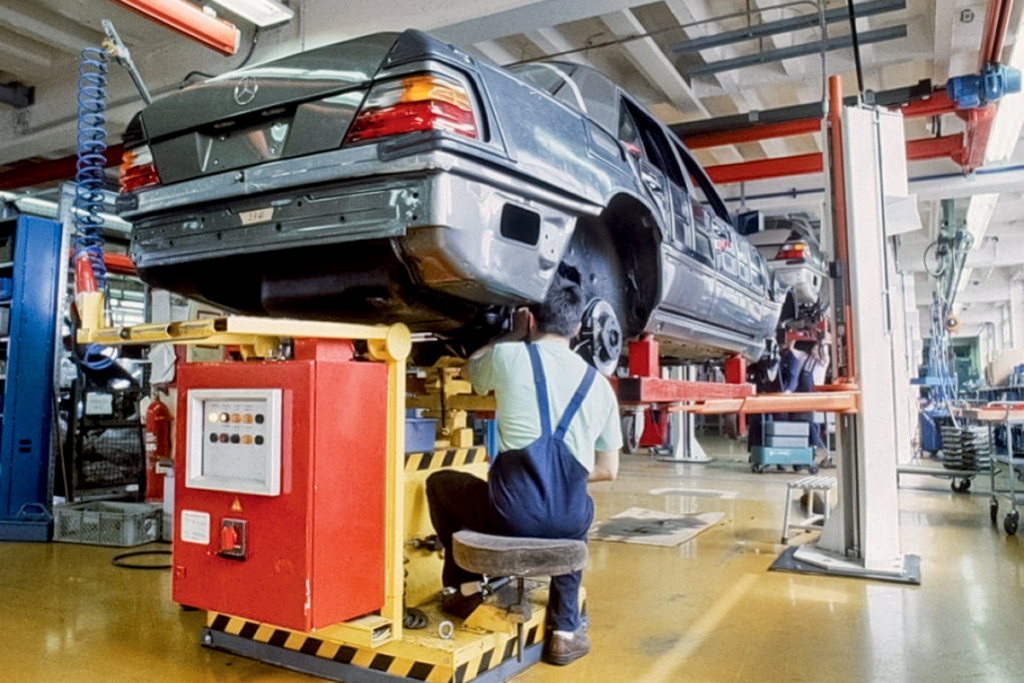
Na fábrica da Porsche, os carros da Mercedes eram montados sem esteira, em elevadores e carrinhos. O código VIN desses carros deve incluir os números 124.036.
Por fim, o Mercedes 500 E foi montado em três locais. Painéis estampados da carroceria foram transportados de Sindelfingen para Zuffenhausen, onde a Porsche adicionou peças e as montou em estruturas no edifício Reutter Bau, em homenagem à histórica Reutter Karosseriewerk, uma oficina que trabalhou com Ferdinand Porsche desde 1906 e desempenhou um papel significativo nas primeiras carrocerias dos carros Porsche. Após a montagem inicial, as molduras foram devolvidas a Sindelfinden para pintura e depois a Zuffenhausen para montagem final na fábrica de Rössle Bau, anteriormente sede da produção do Porsche 959.
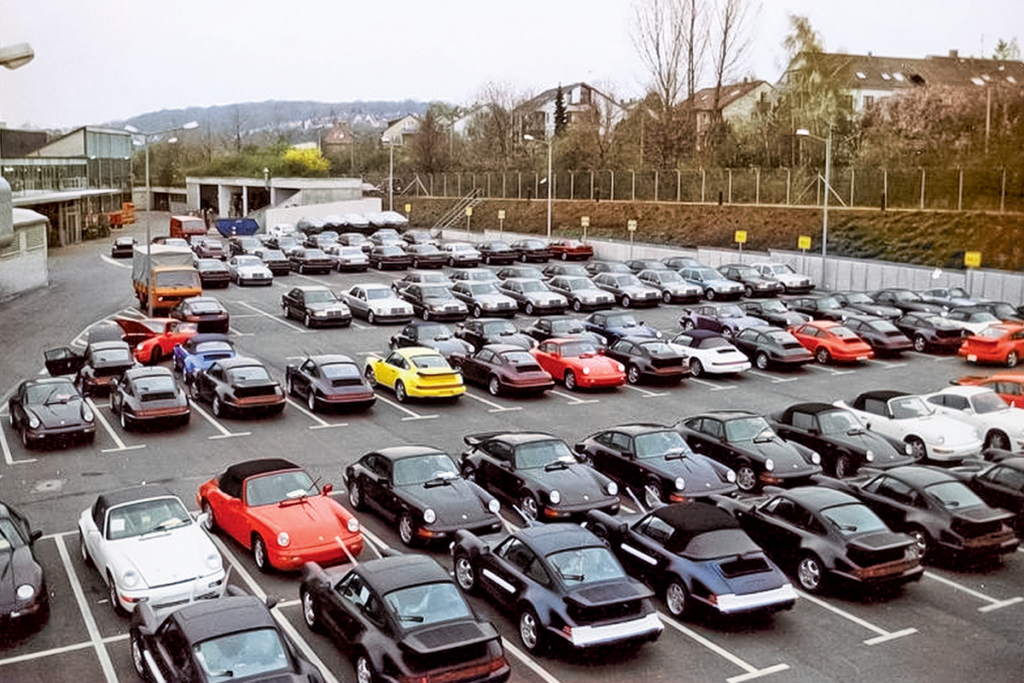
No início dos anos 90, os produtos acabados na fábrica de Zuffenhausen: vários Porsche 964 e quarenta Mercedes ao fundo.
A complexidade logística desse processo foi considerável; foram necessários 18 dias para fabricar cada veículo. Apesar disso, o processo de produção se mostrou mais eficiente do que o do BMW M5. Inicialmente, a Mercedes planejou que a Porsche produzisse dez carros diariamente, mas devido à grande demanda, as taxas de produção dobraram.
Com um preço superior ao da classe S em 135.000 marcos alemães, com um pico na demanda e na produção em 1992, o 500 E logo fez a transição para o E 500 como parte do facelift de 1993 que transformou toda a série “124″ na classe E. Embora a engenharia tenha permanecido a mesma, o aumento de preço para 146.000 marcos levou a um declínio nas vendas, culminando na cessação da produção em 1995. No entanto, o menos potente 400 E (mais tarde E 420) continuou até 1996 em números duplos.
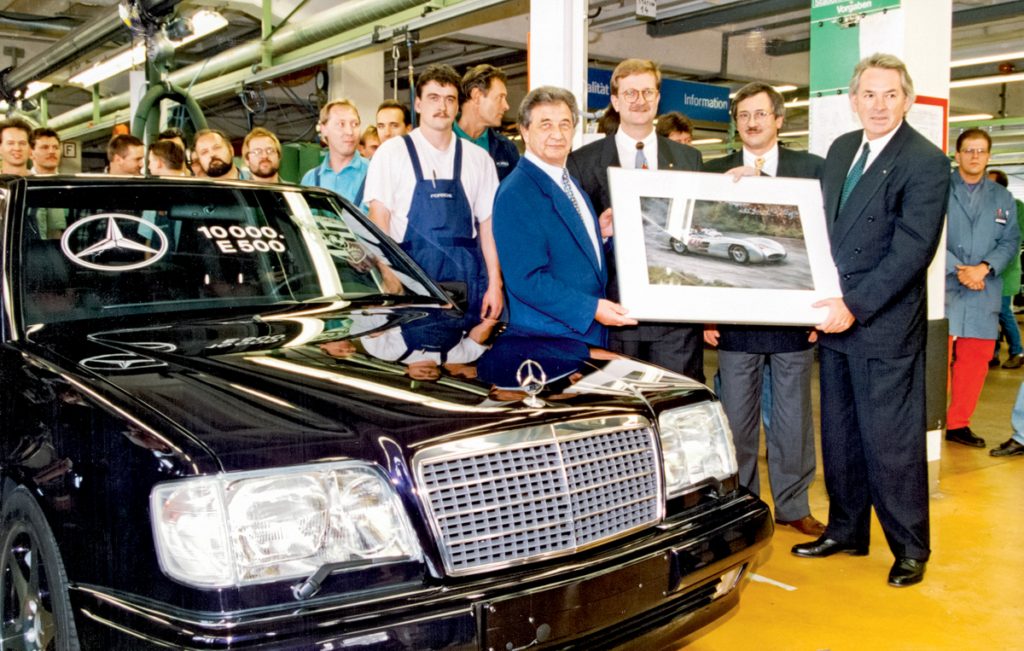
O 10.000º Mercedes “Quinhentos” foi produzido em outubro de 1994 – já com o índice E 500. Depois disso, outras 479 unidades foram montadas. O carro foi presenteado a Hans Herrmann, que correu pela Mercedes na Fórmula 1 nos anos 50, e em 1970 venceu a primeira Le Mans pela Porsche.
Este projeto não apenas estabilizou a situação financeira da Porsche, mas também preparou o terreno para projetos futuros, como o Audi RS2, onde a Porsche exerceu uma maior influência na engenharia. A liderança de Michael Hölscher se estendeu além desse projeto, contribuindo para o desenvolvimento do Carrera GT e do Porsche 918 Spyder antes de sua aposentadoria em 2016.
A Mercedes, tendo reconhecido a natureza lucrativa dos modelos de desempenho por meio do projeto 500 E, decidiu em 1993 manter esse “caviar” do setor automotivo exclusivo, levando ao lançamento do primeiro Mercedes C 36 AMG e preparando o terreno para futuras inovações de alto desempenho conhecidas hoje em dia.
Foto: BMW | Mercedes-Benz – Brasil | Sergey Znaemsky
Esta é uma tradução. Você pode ler o artigo original aqui: Эхо друг друга: как создавались BMW M5 и Mercedes-Benz 500 E из нашего ретротеста

Publicado Junho 20, 2024 • 12m de leitura

